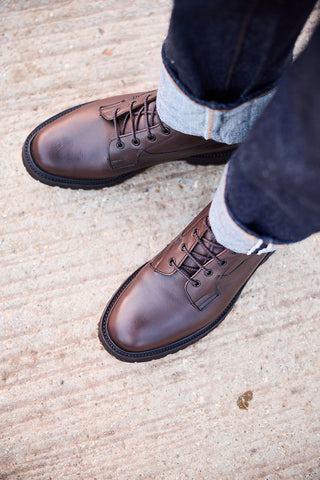
There are a couple of footwear styles every discerning man should have in his wardrobe. The iconic Penny Loafer is certainly one of them, stylish, unpretentious, classic and effortless, this simple shoe has an interesting history.
History of the Penny Loafer Design
Did you know the style dates back to Norway in the early 1930s?
After learning his shoemaking skills in America, Norwegian Nils Gregoriusson Tveranger designed a new slip-on shoe. Called the Aurland moccasin is was also knows as the Aurland shoe. Taking inspiration from the moccasin shoes worn by Indigenous people in North America, and the simple slip-ons on the feet of Norwegian fishermen, the first design was born.
Popularity grew and export orders were sent across Europe and America. Esquire magazine even featured an article with photographs of Norwegian farmers wearing the shoe in cattle loafing sheds. 
Soon after, the Spaulding family of New Hampshire, USA, began manufacturing a similar shoe, called The Loafer. This name later became a generic term used to describe a slip-on, moccasin shoe.
In 1934, G. H. Bass made his first version of the loafer which he called Weejuns. This appears to be a play on words on the origin of the original designer - Norwegian. A distinctive feature of this new design was a strip of leather stitched across the saddle of the shoe, featuring a shaped cutout.
Why are they called Penny Loafers?
In 1950s America before trainers were invented, the Weejun became the shoe of choice for young men and students. It became fashionable to keep a dime in the half moon cut out slot of the leather strip. This eventually gave the shoes their colloquial name of Penny Loafer, which is still used today.
The Tricker's Penny Loafer
For many years, Tricker’s has made various designs of the classic loafer. A firm favourite is the James. A solid construction finished on a single leather sole.
For SS18, we have added a few different loafer styles to our collection.
Another popular loafer is the Adam. Built on our recently designed flexi welt sole, this particular version is lighter in weight making it more suitable for warmer weather and casual dressing.

Produced with the same characteristics of a hard-wearing welted shoe, the flexi welt features the following:
- lighter weight leather sole and leather insole;
- cork filler;
- fully lined just using Castorino suede;
- special light weight reverse Castorino calf suede.
This deconstructed flexi shoe is thirty percent lighter than our standard country footwear. However, it remains as durable and solid as you would expect from shoes and boots produced by England’s oldest shoe maker.

How to care for your leather penny loafers
- Remove dirt or marks then polish with a polishing cloth.
- Once a fortnight use shoe cream to nourish the leather,
- Once a fortnight use polish for shine and weatherproofing. Use black or neutral polish.
- Keep your shoes in their shoe bags to prevent damage.
- Use shoe trees to help maintain shape.
How to care for your suede loafers
- For Mud Stains: use a bristle suede brush when the mud is dry.
- For other stains: Scotch Brite is very good at removing most stains, but excessive cleaning may cause permanent damage.
- Kudu suede has a very soft nap. Watch our videos to see how to brush and care for suede.
- Use the correct type of soft shoe brush.
- Keep your footwear in their shoe bags to prevent damage.
- Use shoe trees to help maintain shape.
Explore our full range of Penny Loafers here
Follow us on Instagram for new product, offers and behind the scenes information.
Why not post photos of your beloved Tricker’s footwear using #mytreasuredtrickers for a chance to be featured on our page.


